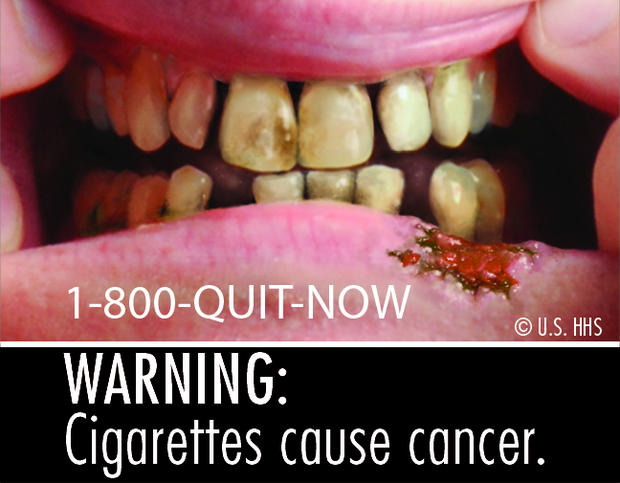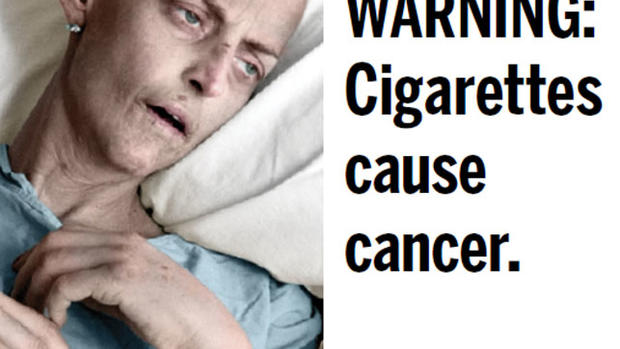Cigarette warning labels praised, attacked for graphic images (PICTURES)
(CBS/AP) The new cigarette warning labels the FDA introduced on Tuesday feature some pretty graphic images to convey the negative health effects of tobacco use.
How graphic? We're talking pictures of rotting teeth, diseased lungs, and a smoker's corpse. And if the pictures aren't enough to deter people from lighting up, the labels also include phrases like "Smoking can kill you" and "Cigarettes cause cancer."
PICTURES - 27 cigarette warning labels nixed by the FDA
The nine new labels - a subset of 36 proposed labels introduced by the FDA last November - are being called the most sweeping change to U.S. cigarette packs in 25 years. The agency is hopeful that the labels will effectively convey the dangers of tobacco use, which kills about 443,000 deaths in the U.S. a year.
The labels will take up half of the front and back of each pack of cigarettes. Warning labels also must constitute 20 percent of each tobacco advertisement. Cigarette makers, who have until the fall of 2012 to comply, are doing what they can to block the labels, claiming in a lawsuit that the warnings would relegate the companies' brands to the bottom half of the cigarette packaging, making them "difficult, if not impossible, to see."
In recent years, more than 30 countries or jurisdictions have introduced labels similar to those being introduced by the FDA. The U.S. first mandated the use of warning labels stating "Cigarettes may be hazardous to your health" in 1965. Current warning labels - a small box with black and white text - were put on cigarette packs in the mid-1980s.
The FDA says the new labels will "clearly and effectively convey the health risks of smoking" aimed at encouraging smokers to quit and discourage nonsmokers and youth from starting to use cigarettes.
"These labels are frank, honest and powerful depictions of the health risks of smoking," Health and Human Services Secretary Kathleen Sebelius said in a statement.
American Cancer Society CEO John R. Seffrin applauded the new labels in a statement, saying they have the potential to "encourage adults to give up their deadly addiction to cigarettes and deter children from starting in the first place."
Studies suggest that warning labels do spur people to quit. The new labels offer the opportunity for a pack-a-day smoker to see graphic warnings on the dangers of cigarettes more than 7,000 times per year.
The FDA estimates the new labels will reduce the number of smokers by 213,000 in 2013, with smaller additional reductions through 2031.
The World Health Organization said in a survey done in countries with graphic warning labels that a majority of smokers noticed the warnings and more than 25 percent said the warnings led them to consider quitting.
While some have voiced concerns over the hard-hitting nature of some of the labels, those concerns should be trumped by the government's responsibility to warn people about the dangers of smoking, said David Hammond, a health behavior researcher at the University of Waterloo in Canada, who worked with the firm designing the labels for the FDA.
"This isn't about doing what's pleasant for people. It's about fulfilling the government's mandate if they're going to allow these things to be sold," Hammond said. "What's bothering people is the risk associated with their behavior, not the warnings themselves,"
Canada introduced similar warning labels in 2000. Since then, its smoking rates have declined from about 26 percent to about 20 percent. How much the warnings contributed to the decline is unclear because the country also implemented other tobacco control efforts.

